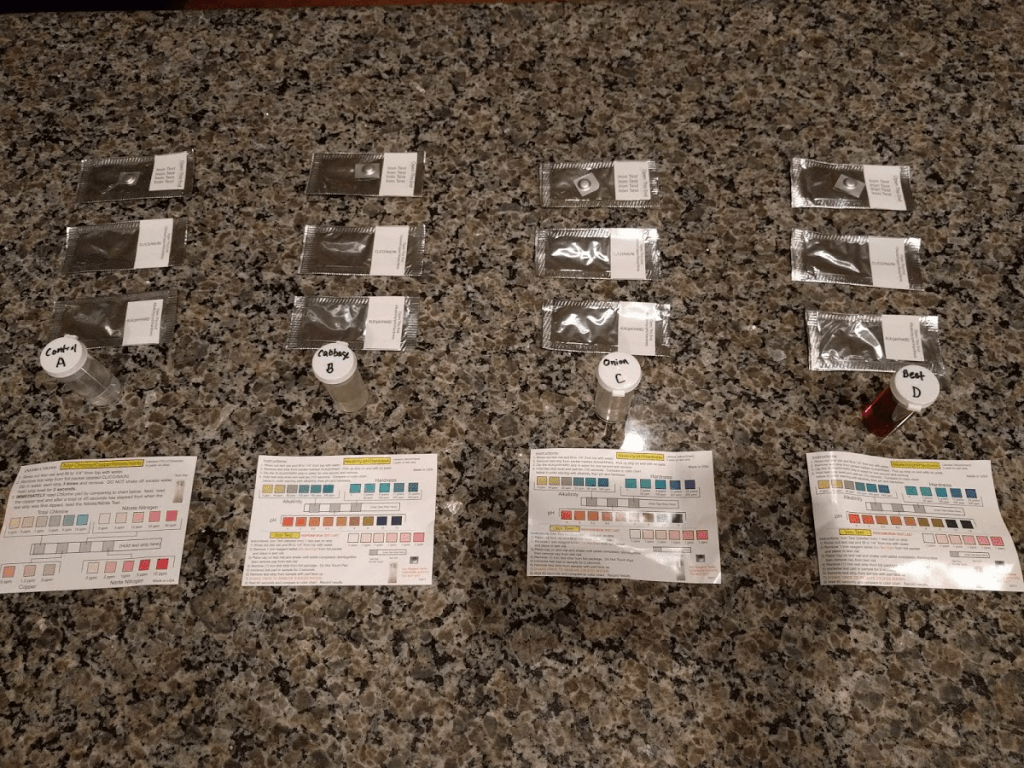Tea is a popular beverage any time of day. Some people drink it plain, while others add milk and some prefer sugar. Milk and sugar certainly change the way a cup of tea tastes, but did you ever consider how it may change the composition of what started out as plain water? Using Test Assured’s 4 Test Kit Set for Schools and Science Fairs is an exciting way to take a look at how a tea bag, milk, and sugar can change the composition of a plain cup of hot water. This set includes 4 test kits and is appropriate for children in grades three through twelve.
Supplies
The first thing you need to do is gather your supplies:
- Test Assured 4 Test Kit Set with TD Meter
- 1 mug of hot water
- 3 empty mugs to prepare samples
- 1 tea bag
- Measuring cup
- Measuring spoon
- Milk
- Sugar
- Paper towels


Preparation
To prepare for the tests, you’ll need to start with a 1 cup of hot water. Set aside ¼ cup of hot water for your control sample. Place a tea bag in a mug with the rest of the water and allow to steep for five minutes. Remove the tea bag and divide the tea into three mugs, each containing ¼ cup of water. Mix 1 teaspoon of milk into one mug of tea and 1 teaspoon of sugar into another. You should now have four mugs with samples.

You may want to use tape to attach a label to each mug to identify your samples, so they do not get mixed up. Don’t forget to label your vials too.
Testing
The first test you want to start with is for total dissolved solids, using the TDS meter. The meter will not fit in the test vials, so it is easier to complete this part of the experiment while your samples are still in the mugs. To perform the TDS test, simply turn on the meter and submerge the prongs in the samples. Rinse the meter with clean water between each test. Record your results in the results notebook.
Read the TDS meter carefully. Because we are adding ingredients that change the composition of the tea, it is not unusual to get an extremely high TDS reading. You’ll notice in the picture that when we measured the total dissolved solids in the tea with milk, the reading was “118 x10.” The arrow is pointing to where you will see the “x10” if you have a high reading like ours.

After completing the TDS test, you will need to pour your samples into the vials you labeled. Fill each vial to within a ¼” of the top. Be sure to wipe up any spills, so you don’t contaminate the test strips.
You may want to take a moment to write your visual observations in the “Notes” section of the results notebook. Comments about how clear or cloudy your samples are may be helpful as you are analyzing the results.

Once you have your work area organized, its time to start the tests. It’s best to work with one sample at a time to avoid contamination. Follow these instructions to complete the remaining tests.
Alkalinity/pH/Hardness Test
- Remove the test strip from the packet labeled, “ALK/pH/Hard”
- Pick up the strip on the end with no pads
- Dip the strip in the sample for one second and remove
- Hold the test strip level and wait 10 seconds
- Place the strip as shown in the picture and compare to the color chart for alkalinity, pH, and hardness
- Record your results in the results notebook

Total Chlorine/Copper/Nitrate/Nitrite Test
- Remove the test strip from the packet labeled, “CL/CO/NA/NI”
- Pick up the strip on the end with no pads
- Dip the strip in the sample three times and remove – DO NOT SHAKE OFF EXCESS WATER
- Hold the test strip level for 2 seconds
- Place the strip as shown in the picture and compare to the color chart for chlorine and copper
- Wait 45 seconds before reading the results for nitrate and nitrite
- Record your results in the results notebook

Iron Test (Complete this test last)
- Remove one iron reagent tablet from the foil packet and place in test vial (the reagent could alter the results of other tests which is why the iron test is completed last)
- Place the cap on the test vial and shake for approximately one minute, until the tablet is completely dissolved
- Remove the test strip from the packet labeled, “Iron Test”
- Dip the strip in the sample for 2 seconds
- Shake the strip once and wait 60 seconds
- Place the strip as shown in the picture and compare to the color chart for iron
- Record your results in the results notebook

Repeat all three tests for each of your samples.
Results
Now that you have completed each of the four tests on your four samples, it’s time to look at your results. Ask yourself these questions:
- Did adding a tea bag to the water have an impact compared to the control sample of plain water?
- How did adding sugar change the composition of your sample?
- How did adding milk change the composition of your sample?
- Which ingredient, sugar or milk, produced the most changes?
- Which sample contained the most dissolved solids?
- What results did you find the most surprising?
Record your answers on the “Notes” page. If you are using this as a science fair project, you can use clear tape to fix the test sticks to the color charts to display your results. You may also want to create a chart or graph of the data you recorded in the results notebook.
